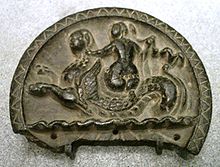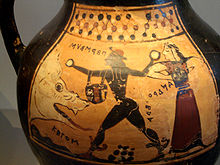Keto (mythology)

Keto ( ancient Greek Κητώ ), also Ketos , Latin Cetus , is a sea monster , whale or large fish in Greek mythology .
Keto is the daughter of Pontus and Gaia . With her brother, the ancient sea god Phorkys , she gave birth to the Gorgons and Graiai as well as Echidna and Ladon . When the Ethiopian Queen Cassiopeia claims to be much more beautiful than the Nereids , the beautiful sea nymphs, at the request of the Nereids Keto , the sea god Poseidon angrily sends Keto to Ethiopia to devastate the country, after which it is finally decided, on the advice of a seer , Cassiopeias Sacrifice daughter Andromeda . Andromeda is tied to a rock on the seashore, where she finally finds Perseus and immediately falls in love. Keto is already swimming towards them when Perseus asks the approaching parents to save Andromeda's hand and is promised not only them, but the whole kingdom, should he succeed.
In one version Perseus shows the monster the head of Medusa , whereupon Keto sinks petrified in the sea, in another version, which among others recounts Gustav Schwab , there is a dramatic fight in which Perseus uses the magic sword he received from Hermes . Perseus finally manages to kill Keto.
See also
literature
- Hesiod , Theogony 238, 270 f., 330, 336 f.
- Gustav Schwab , The most beautiful sagas of classical antiquity [1]
